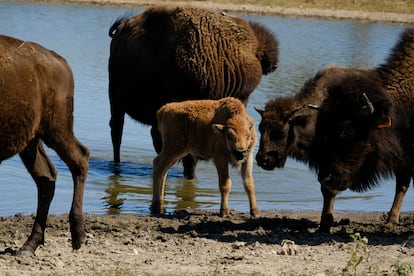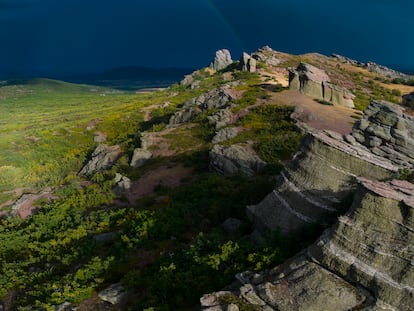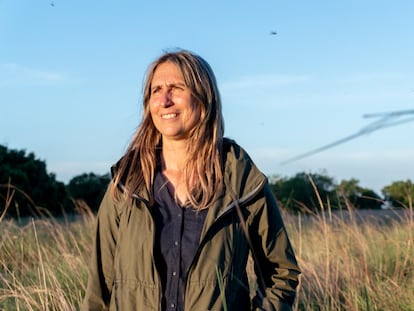American bison reintroduced to northern Mexico helping to fight climate change
The largest land mammal in America is rehabilitating a vast grassland in Coahuila, benefiting hundreds of species in a reserve that can theoretically store 6.3 million tons of carbon in its soil

Dozens of American bison graze in the wide-open fields of El Carmen (Coahuila), a reserve of 140,000 hectares, roughly the same size as Mexico City. The country’s northern plains had not played host to the bison in 100 years, after decades of indiscriminate hunting and habitat destruction eradicated the animals. In 2021, following an initiative led by the Mexican multinational cement company Cemex, bison returned to the grasslands, where the soil stores huge amounts of carbon, making the region key to the fight against climate change. Initially, 19 bison were introduced at the reserve; today there are almost 100. The mammal’s daily routine makes it a perfect vehicle for regenerating grassland vegetation and sustaining hundreds of species that coexist with it.
“The even pruning of the grasses [produced by the bison as they eat] helps to increase the diversity of plants on the ground. They also take care of the regeneration of ecosystems by carrying seeds from one place to another in their digestive tract and defecating them,” explains Rurik List, a researcher in environmental sciences at the Autonomous Metropolitan University (UAM) in Mexico City. The bison is a temperate animal, which unwittingly encourages other species to survive in the spaces it inhabits. Its considerable weight flattens the grassland in its path, an alteration that helps rodents such as the Mexican prairie dog, which requires short grass to be able to keep watch for predators.
Cemex carries out various different conservation initiatives to try to offset the impact of its operations. The company has more than 250 active quarries around the world, and tries to minimize its footprint from several perspectives: rehabilitating the sites they have exploited, preparing them before starting work to protect their biodiversity, and promoting spaces such as the El Carmen reserve, which Cemex became involved with 22 years ago. “From the beginning, a series of studies were carried out to determine what was most appropriate at the reserve. An inventory of flora and fauna was taken to determine which conservation targets should be retained. And an analysis was done to determine the status of the habitat,” says Alejandro Espinosa, director of the El Carmen reserve.

1,000 kilos and a 14-kilometer stroll
The bison is the largest land mammal in North America: it can stand more than 1.6 meters tall and weigh well over 1,000 kilograms (2,200 pounds). Espinosa finds the animals fascinating: “Did you know that a bison can walk up to 14 kilometers [8.6 miles] a day?” On its long walk, the bison scratches itself against the trees to relieve itself from flies. The hair it sheds is used by birds for their nests, again contributing to the conservation of other species.
Their passage through the grasslands helps to maintain the biodiversity of the area. “They urinate and defecate. When they die, that’s 1,000 kilos of fertilizer decomposing. They are also eaten by scavengers when they die and when they are alive, they are also consumed, occasionally by wolves, but more occasionally by grizzly bears and cougars. They are also a prey species,” List explains.
The executive director of the U.S. National Bison Association, Jim Matheson, says the American mammal’s wild instincts are key: “The bison was never domesticated and, as such, retains the innate herding instincts that make it the ideal ruminant to recover the North American grasslands.”
A hidden lung on the plains
Cemex began rehabilitating the reserve with the help of environmental authorities, universities, scientists, and the support of the U.S. National Park Service. More than two decades later, the landscape is different. “It was rare to see wide vegetation cover: there were a lot of rocks and the whole process of overgrazing had just passed. The place was divided into paddocks, with fences. One of the first actions taken was to open up the landscape [...] More than 20,000 hectares of grasslands that had been invaded by scrub were restored and after several years of work, we decided that it was time for native species of the area that grazed naturally grazed,” says Espinosa. Bison were among those species, which were methodically selected. The company tried to select the purest specimens possible — for their survival, bison have previously been bred with cattle. The result was 19 bison (three males and 16 females) brought in from other areas of North America.
Grasslands are one of the planet’s hidden lungs. The Food and Agriculture Organization of the United Nations (FAO) argues that these lands can store and capture a greater amount of carbon than forest ecosystems — up to 30% of the planet’s CO2. To these beneficial characteristics, List adds another: resistance to fires. “Ninety percent of the carbon in the grasslands is under the soil. If there is a fire, 10% will be burned but 90% will remain, which, as soon as the rains come, will grow again, unlike forests such as those in the Redd+ program [dedicated to carbon storage], whose carbon reserves are released into the atmosphere when they burn.”
The Mexican National Commission of Natural Protected Areas (Conanp) estimates that grasslands can absorb up to 45 tons of carbon per hectare. The 140,000 hectares that make up the reserve can theoretically hold 6.3 million tons.
Iconic in the United States
This year, the Coahuila reserve witnessed the birth of its second generation of native offspring, further evidence of its settlement. So far, Espinosa has counted a total of 94 American bison. Conanp states that 300 years ago there were between 30 and 60 million bison in North America. By 1880, the population had been reduced to just over 1,000.
Matheson says that the IUCN Red List, which determines the danger of extinction among a wide range of species every five years, has downgraded bison. “It has not been threatened with extinction for several years and the herd has proliferated on all interested fronts - private, agricultural, tribal and conservation - in recent years. I believe that the current bison herd is quite stable.”
Bison, once an important source of food and furs for the native peoples of North America, has flourished on its return to the northern grasslands of Mexico. In just two years, its population has grown by more than 60 animals. “You have bison, you have grasslands; you have grasslands, you have carbon in the soil. You lose the bison and you start to lose the grasslands,” List concludes.
Sign up for our weekly newsletter to get more English-language news coverage from EL PAÍS USA Edition
Tu suscripción se está usando en otro dispositivo
¿Quieres añadir otro usuario a tu suscripción?
Si continúas leyendo en este dispositivo, no se podrá leer en el otro.
FlechaTu suscripción se está usando en otro dispositivo y solo puedes acceder a EL PAÍS desde un dispositivo a la vez.
Si quieres compartir tu cuenta, cambia tu suscripción a la modalidad Premium, así podrás añadir otro usuario. Cada uno accederá con su propia cuenta de email, lo que os permitirá personalizar vuestra experiencia en EL PAÍS.
¿Tienes una suscripción de empresa? Accede aquí para contratar más cuentas.
En el caso de no saber quién está usando tu cuenta, te recomendamos cambiar tu contraseña aquí.
Si decides continuar compartiendo tu cuenta, este mensaje se mostrará en tu dispositivo y en el de la otra persona que está usando tu cuenta de forma indefinida, afectando a tu experiencia de lectura. Puedes consultar aquí los términos y condiciones de la suscripción digital.
More information
Archived In
Últimas noticias
Maduro pleads not guilty before the federal court in New York: ‘I am still the president of Venezuela’
A new test can detect Alzheimer’s from a finger prick
UN team enters Sudanese city of El Fasher after paramilitary massacre: ‘It’s like a ghost town’
A recipe for resistance: Indigenous peoples politicize their struggles from the kitchen
Most viewed
- Gilles Lipovetsky: ‘If you want to live better and fall in love, take Prozac, don’t look to philosophy’
- Alain Aspect, Nobel laureate in physics: ‘Einstein was so smart that he would have had to recognize quantum entanglement’
- Alvin Hellerstein, a 92-year-old judge appointed by Bill Clinton, to preside over Maduro’s trial in New York
- Maduro’s downfall puts China’s relationship with Venezuela to the test
- Why oil has been at the center of Venezuela-US conflicts for decades











































